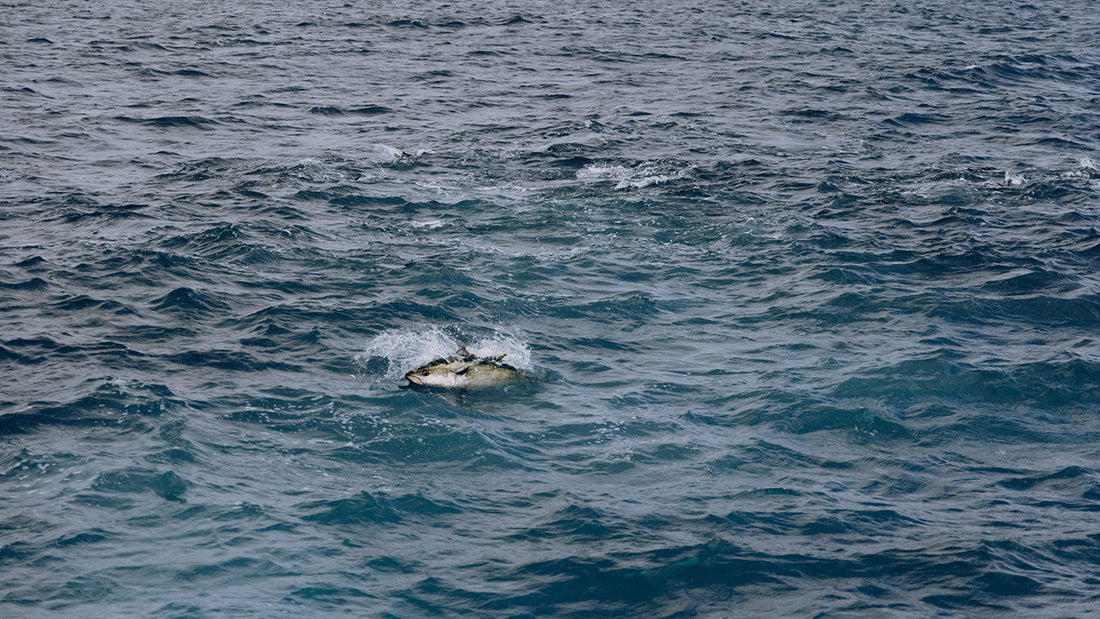
Bluefin Tuna Explained + Scientific Tuna Tagging
The three species of bluefin tuna are the reason many people are anglers. They are why anglers can tell the best fishing story anyone has ever heard and why some have a few patches of white hair. From the epic stories to the agonies of defeat, the Bluefin is the common denominator. Check out AFTCO’s Species Spotlight on the Bluefin Tuna to learn more about the species.

Aside from observations from the angler, many questions get answered by scientists studying and tracking the species. Observations made by anglers on the water help trained scientists take it a step further by using their tools to learn more about the species. The bluefin tuna is no exception. Scientific studies help uncover more about tuna behavior and how to keep their populations steady. Groups such as Tag-A-Giant are pushing the envelope on bluefin tuna research.

Who Studies Bluefin Tuna?
Being the apex predator that the Bluefin tuna is, a lot of research and studies have been conducted and are in progress on this species. Apex predators are essential to the ocean because the species plays a vital role in the ecosystem by feeding on intermediate predators. These predators then feed on prey, which feeds on smaller organisms at the base of the food chain. There are many different species in the lower trophic levels of an ecosystem. Still, once you get to the top, there are fewer apex predators, so if their population declines, it can topple an ecosystem by simply not feeding on the intermediate predators.
Because of this dynamic, you find many scientific institutions researching bluefin tuna. One of the most effective tools in studying these species is tracking. Many tools are used to track, including satellite trackers, acoustic telemetry tracking, and visual tracking. With highly migratory species like BFT, satellite tracking is the more effective method. Groups like Tag-A-Giant support tagging BFT efforts in the Pacific and Atlantic to learn as much as possible about this species.

Tag-A-Giant
Tag-A-Giant (TAG) is committed to reversing the decline of the northern Bluefin species by supporting the scientific research necessary to conserve them. Understanding that bluefin are apex predators means they have a critical role in the ecosystem and need further understanding to properly plan conservation initiatives.
TAG research is showing the world how to improve management of bluefin fisheries to chart a course to recovery of the species. TAG has pioneered the field of electronic tagging, catching and releasing 1,800 wild bluefin tunas with modern devices that record their journeys through the sea. AFTCO and CCA California is in support of TAG and have been involved in assisting them with capturing and tagging efforts in the Pacific and Atlantic Oceans. To learn about some of these efforts, watch our Bluefin Tagging Video here.
Where Do Bluefin Tuna Spawn?
A crucial question to any migratory species is where they spawn. Understanding where they spawn can answer other questions regarding where they might go at a specific time of the year and how old they are when they go. These are all aspects that Dr. Barbara Block and Tag-A-Giant are trying to answer with the Pacific Bluefin. They found that Bluefin are born off the coast of Japan and Taiwan. When they are young, they swim across the Pacific Ocean to the West Coast of North America. Here they spend a few years following bait and currents growing larger until they become sexually mature estimated to be at seven years of age and weigh above 200 pounds, and swim back to Japan and Taiwan to reproduce.
The Atlantic Bluefin reproduces in the Gulf of Mexico as well as in the Mediterranean Sea. They trek around the Atlantic Ocean, always returning to their spawning grounds starting at ten years old. Sportfishing organizations such as the International Game Fish Association (IGFA), American Sportfishing Association (ASA), Coastal Conservation Association (CCA) and Center For Sportfish Policy (Center) are working with marine scientists and partners in the environmental community to prevent longlines from harming the Atlantic Bluefin spawning in the Gulf.

Where Can You Find Bluefin Tuna?
Bluefin Tuna are found around the entire planet. Their distribution along all three oceans can be described by what happens inside their muscles. Tuna can inhabit most open oceans and seas because they are regional endotherms. That is a fancy way of saying they are warm-blooded. BFT can regulate their body temperature thanks to blood vessels that keep warm blood around the muscles. Having warm blood around the muscles means the tuna can keep their muscles warm regardless of the surrounding ocean temperatures.
Starting with the Pacific Bluefin Tuna, as the name implies, we find this tuna in the Pacific Ocean. We see these tunas in the western Pacific Ocean near Japan and Taiwan in their known spawning grounds and in the Eastern Pacific, where they feed, swimming in a figure-eight motion along the Eastern Pacific. The feeding grounds used to be more in the southern hemisphere but have recently shifted in the reach of North American Fishing Fleets. They make the migrations back and forth, but their range extends to the south around Australia and New Zealand. This overlaps with the Southern Bluefin Tuna and is a more uncommon occurrence down under.
The Atlantic Bluefin occupies the Atlantic Ocean from the Gulf of Mexico to the Mediterranean Sea and north into Canada across to Iceland. There are two leading stocks of Atlantic Bluefin; one stock spawns in the Gulf of Mexico and the other in the Mediterranean Sea. These two stocks then do what the Pacific Bluefin do and migrate to feeding grounds. At first, these two stocks were thought to stay separate, but now there is evidence that they feed in similar areas around the Atlantic before returning to the spawning site where they were born. Because of this, it has been suggested that it is possible to genetically isolate these two tuna stocks due to not breeding with the other stock, even though they interact throughout their lives on feeding grounds.
What Do Bluefin Tuna Eat?
Depending on the ocean, different prey species are on the bluefin tuna menu. However, tuna cannot suck prey into their mouths like some fish like groupers. They must catch prey and fit it into their mouths. Smaller tuna tend to feed on smaller prey until their mouths are big enough to open around larger prey. As juveniles, most tunas feed on small crustaceans, squid, and smaller baitfish, and when they grow larger, they can feed on larger baitfish like mackerels and even flying fish and eels.

Are Bluefin Tuna Endangered?
As of 2021, the classifications of the three bluefin species have changed from what many are familiar with.
Many have considered the Atlantic Bluefin incredibly overfished and critically endangered. However, they have been taken off the IUCN Red List and are considered “least concern” now. Proper and effective fisheries management and the science gained from organizations like the Tag-A-Giant Program have contributed to this success story. While regulations and commercial catch limits on the East Coast of North America have successfully started an Atlantic Bluefin recovery, it is critical not to let commercial catch rates climb back to a point that reverses the current positive trend with the Atlantic Bluefin.
Unfortunately, the Southern Bluefin Tuna is the only critically endangered bluefin species on the planet. This species is the smallest bluefin species and has been over-exploited for many years. Current regulations are limited to Total Allowable Catches (TAC) by neighboring countries that fish for this species. Unfortunately, there is not much evidence suggesting the populations are recovering, but the IUCN suggests the Southern Bluefin population trend is increasing, which is a good sign.
The Pacific Bluefin Tuna has become increasingly popular in areas such as Southern California, with the species becoming more in reach of the sportfishing fleet. Unfortunately, many factors have led to the Pacific Bluefin Tuna being considered “near threatened” and a declining population trend. Conservation measures and more data are needed to understand better the movement patterns and spawning information to assist in making effective fisheries regulations to help this species stick around for generations. Critical information is required on the Pacific Bluefin Tuna to determine their actual spawning age. One of the goals of the current tagging programs is to do just that.
The three species can be hard to manage appropriately because of their migratory nature. When tuna travel across borderlines, the jurisdiction changes on who manages the tuna. The fault lies in some country’s fisheries management being less strict than other countries. For several reasons, the exploitation of a species can occur because the animals swim into another country’s waters with the threat of overfishing. Therefore, groups like the International Commission for the Conservation of Atlantic Tuna (ICCAT) exist to assist in international regulation of migratory species and have become a great asset to the conservation of the Atlantic Bluefin Tuna.






